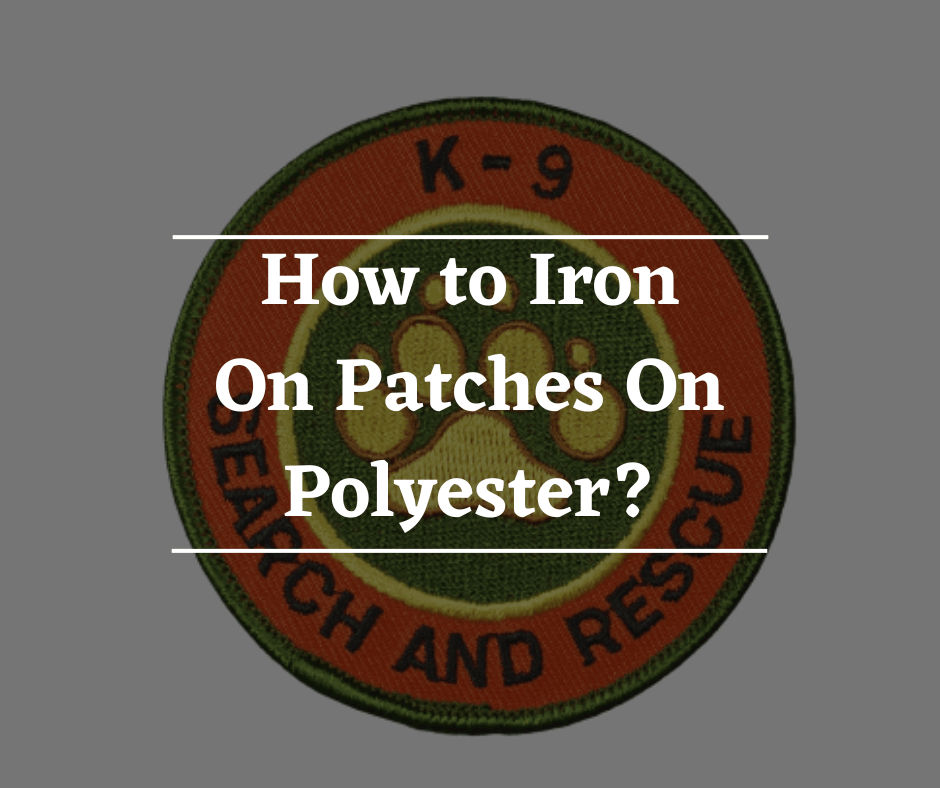How to Iron-On Patches on Polyester

Are you not sure how to spruce up your wardrobe with a few iron-on patches? Not to worry! Adding patches to your clothing is easy, and we’ll show you how simple it is here. With the right tools, patching polyester fabric can be fast work that yields impressive results.
Imagine customized t-shirts or jeans bearing colorful designs of your making – the possibilities are exciting! We’ll cover the basics about how to iron on patches on polyester without fail below. So get ready, and let’s bring those projects to life!
Contents
How to Iron On Patches On Polyester Step By Step
Step 1: Choose The Right Patch
Stick with polyester patches, as they’ll adhere to the fabric best. Avoid nylon or cotton-backed designs – you don’t want to risk the patch coming off in the washing machine! The size and design of the patch will also be critical to a successful iron-on. If your patch and clothing item is too small, you can easily find yourself with a poor fit.
Step 2: Clean And Dry The Polyester Garment
Start with a clean and dry garment before applying the patch. You don’t want dust or dirt ruining the fabrics, so make sure to clean them before proceeding. The clothes should also be dried to ensure the patch won’t slip off later. This is important for all materials, mainly polyester.
Step 3: Set Up The Iron
Start heating the iron to a medium iron heat setting (around 300 degrees Fahrenheit). Select a setting that doesn’t exceed the fabric’s temperature limit, or you risk damaging your clothing. Next, preheat the iron according to the cotton, wool, silk, or polyester material. Adjust the heat for polyester fabric accordingly.
Step 4: Apply The Patch
Place your patch in its desired position and use a pressing cloth to prevent scorching. You may even want to pin the patch first for extra security. If so, make sure to remove any pins before ironing.
Next, press the iron onto the patch and hold it in place for at least 15 seconds. Repeat this step several times until the adhesive has melted into the fabric. Also, apply uniform pressure and proceed in a circular pattern while ironing on the area for effective patch application.
Step 5: Check The Attachment
Before you proceed, check that your patch is appropriately in place. Ensure the corners and edges have entirely fused into the fabric. Once satisfied with the placement, allow the material to cool down before removing the pressing cloth. Then, you can add additional patches until you’ve achieved the desired look. If you are interested in custom iron on patches so checkout this article.
Precautions
More care will ensure that the polyester doesn’t burn up and melts. You may be certain that these will help you avoid unnecessary hassle.
Put the iron at its lowest temperature first. This will prevent the polyester from degrading from the heat itself and make it more difficult to ignite a fire. Also, avoid using steam since this will dampen things and render the low heat ineffective.
Next, get yourself a sheet of waxed paper or any other thin material—cotton is ideal. To avoid rearranging it constantly, it must be sufficiently large to encompass the entire area. Skipping this step means a lot of excess heat will be applied to the polyester, making it more flammable.
Since polyester is so light and sensitive, you must ensure that there is just one component underneath the patch before applying adhesive. It’s easy to accidentally fuse the two sides of a garment if you’re not careful. What’s done is done; there’s no way to change it.
At that point, you may begin ironing. While the adhesive is melting, spend 30–40 seconds applying the patch in slow, flowing movements. Once the timer goes off, see if you can raise the corners and keep the center in place. The circular motions should be repeated until the patch well adheres to the polyester.
Alternative Methods For Applying Patches To Polyester
1. Using A Hot Glue Gun
Instead of dealing with the hassle of ironing, you can just use fabric glue for glue gun patches. Apply some on the patch’s backside, then sew it onto the polyester. Again, use a solid surface and keep in mind no adhesive seeps out from behind it.
You may take off the bottom layer of adhesive prior to applying the patch if you decide it doesn’t look nice with two layers. Then, take a sharp knife and carefully pry up the corners. Be cautious. However, if the adhesive has dissolved into the patch, you are going to have a lot of difficulties.
2. Sewing The Patch Onto The Garment
Sewing patches is a great way to attach patches to polyester and other fabrics. This can be done using a basic sewing machine or using a needle and thread. Make sure to pick out threads that are similar to the colors of the patch and fabric. Alternatively, choose a color that is going to match the design perfectly.
Frequently Asked Questions
Can I iron on patches to polyester fabric?
Yes, you can iron on patches to polyester fabric. As long as you follow the instructions and use a proper patch, you should be able to iron on patches without a problem.
Can I use iron-on patches on other types of fabrics besides polyester?
Yes, you can use iron on patches on other types of fabrics. Some materials, such as cotton and wool, are best suited for iron-on patches, while other fabrics, such as nylon and rayon, may require additional steps.
How do I choose the right patch for my polyester garment?
When selecting patches for your polyester garment, it is always best to choose a patch that is the same size or slightly larger than the area of the garment. Also, select a patch made from high-quality materials, which will help ensure it adheres well to the fabric.
Is it possible to remove patches from polyester fabric?
Yes, if the patch has been applied with glue or an iron-on adhesive, you can remove it by peel-off patch removal method. And, if the patch was sewn onto the fabric, you can remove it with scissors or a seam ripper. However, it is essential to note that removing patches may cause damage to the fabric, so proceed with caution when doing so.
Can I wash and dry polyester garments with patches attached?
You can safely wash and dry polyester garments with patches attached. However, check the instructions on the patch before washing it to ensure it can withstand the heat and agitation of a washing machine. Additionally, use a gentle cycle to help ensure that the patch does not become damaged or detached.
Conclusion
How to iron on patches on polyester is a simple process that can be done in just a few steps. Whether you’re using an iron-on patch adhesive, glue gun, or sewing the patch by hand, as long as you follow the instructions, use a good quality patch, and do proper patch maintenance, you’re sure to get a great result.






